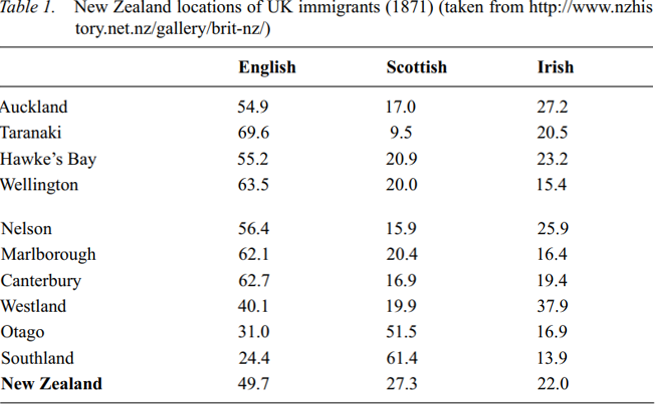


 Grammar
Grammar
 Tenses
Tenses
 Present
Present
 Past
Past
 Future
Future
 Parts Of Speech
Parts Of Speech
 Nouns
Nouns
 Verbs
Verbs
 Adverbs
Adverbs
 Adjectives
Adjectives
 Pronouns
Pronouns
 Pre Position
Pre Position
 Preposition by function
Preposition by function 
 Preposition by construction
Preposition by construction
 Conjunctions
Conjunctions
 Interjections
Interjections
 Grammar Rules
Grammar Rules
 Linguistics
Linguistics
 Semantics
Semantics
 Pragmatics
Pragmatics
 Reading Comprehension
Reading Comprehension|
Read More
Date: 2023-12-01
Date: 2024-03-02
Date: 2023-06-08
|
The early immigrants to New Zealand came from all parts of the British Isles and Australia. Of those who came from England (who made up 49% of the total), by far the largest number of immigrants came from the South of England, and this was the trend at every stage of New Zealand’s development. People from the south, and in particular the southeast, made up a majority of the earliest settlers in the planned settlements (1840–1852); they made up the majority in later government-assisted immigration schemes (1871–1880). The Southern English influence could also have been reinforced by any Australian influence (seen especially at the time of the gold rush and the New Zealand Wars), as Australia was also settled predominantly from the South of England. So although over 20% of the early immigrants to New Zealand were Scottish and a similar percentage were Irish, in the end their phonological influence was overwhelmed by Southern English; the influence of other areas of the British Isles can be seen only in a few lexical and morphological examples.

There is one exception to this general rule, and that is in the Southern part of the South Island of New Zealand – Southland and parts of Otago – where many of the early settlements were predominantly Scottish as shown in Table 1. This influence can still be heard in what is known locally as “the Southland burr”, a semi-rhotic variant of New Zealand English (NZE).
Although the Southland variety of NZE is the only regional variety attested by linguists, there are strongly held lay views that there are other dialects of NZE. A recent broadcast series on “Coastal Dialects of NZE”, for example, claimed that there were strong regional differences in New Zealand. These programmes based this assertion on recordings of single speakers from different parts of New Zealand, without any linguistic comment or discussion. Work by Pamela Gordon (1997) on attitudes towards varieties of NZE demonstrated strongly held local beliefs about the “pseudo-English” of Christchurch and Canterbury, the slowness of West Coast speech, and so on. The view of linguists is that regional phonological variation in New Zealand (apart from Southland) has so far not been demonstrated. However, new evidence is currently emerging that there are intonational differences in Taranaki in the North Island. Folk linguistic knowledge has described Taranaki intonation as “sing song”, and analysis is demonstrating that there are, indeed, more pitch shifts per intonation unit than in other areas of New Zealand. Results like this indicate that detailed analysis may reveal some differences in other regions around the country. Nevertheless such regional differences are minor when compared with those that characterize dialects in other varieties of English, or the Southland variety of NZE to which we now turn.
|
|
|
|
التوتر والسرطان.. علماء يحذرون من "صلة خطيرة"
|
|
|
|
|
|
|
مرآة السيارة: مدى دقة عكسها للصورة الصحيحة
|
|
|
|
|
|
|
نحو شراكة وطنية متكاملة.. الأمين العام للعتبة الحسينية يبحث مع وكيل وزارة الخارجية آفاق التعاون المؤسسي
|
|
|